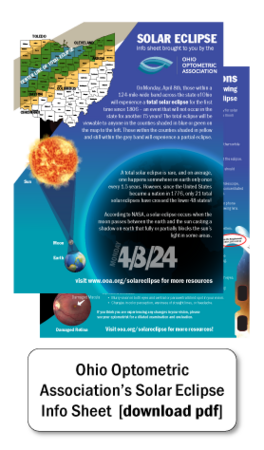On Monday, April 8th, those within a 124-mile-wide band across the state of Ohio will experience a total solar eclipse for the first time since 1806 – an event that will not occur in the state for another 75 years! The total eclipse will be viewable to anyone in the counties shaded in blue or green on the map to the right. Those within the counties shaded in yellow and still within the grey band will experience a partial eclipse. [ See Video HERE ]
A total solar eclipse is rare, and on average, one happens somewhere on earth only once every 1.5 years. However, since the United States became a nation in 1776, only 21 total solar eclipses have crossed the lower 48 states!
According to NASA, a solar eclipse occurs when the moon passes between the earth and the sun casting a shadow on earth that fully or partially blocks the sun’s light in some areas.
Critical Eye Safety Recommendations
from Doctors of Optometry for Viewing Any Part of the Solar Eclipse
It is not safe to look directly at the eclipse unless you are using eye protection specifically for solar viewing. The only exception is during the very brief phase of a total solar eclipse when the moon completely blocks the sun.
How to Safely View The Solar Eclipse
Use approved solar viewers or filters when viewing the eclipse, and do not remove them while looking at the eclipse.
- If the solar filter or shades are scratched or damaged, they are not safe.
- Always supervise children using solar shades. Children and Teens can be tempted to look at the sun without proper protection.
Homemade filters or regular sunglasses, even if dark, are NOT safe for looking at the eclipse.
Safe solar shades are thousands of times darker than regular sunglasses and should comply with the ISO 12312-2 international standard.
Do not look at the sun through a camera (including your phone camera), a telescope, binoculars, or any other optical device while using your solar viewers — the concentrated solar rays will damage the filter and enter your eye(s), causing serious injury.
Do not directly view any part of the eclipse through a camera (including your phone camera), binoculars, or a telescope without a solar filter placed over the viewing lens.
The Ohio Optometric Association does not endorse any particular brand of solar viewers. Go to the American Astronomical Society website at https://eclipse.aas.org/eye-safety/viewers-filters to find a list of approved sellers
- Unscrupulous vendors can grab the ISO logo off the internet and put it on their products and packaging, even if their eclipse glasses or viewers haven't been properly tested. This means that just seeing the ISO logo or a label claiming ISO 12312-2 compliance isn't good enough. You need to know that the product comes from a reputable manufacturer or one of their authorized dealers.
- Some vendors claim that their solar viewers are approved or endorsed by NASA. NASA does not approve or endorse products.
Purchase AAS/ISO/CE certified eclipse glasses through www.eclipsesunglasses.com and receive free shipping using coupon code: STATE-PAC. Deadline for USPS Priority Mail shipping is Friday, March 29, 2024.
What Could Happen to My Eyes ?
Photochemical toxicity from UV rays can cause painless damage to the center of
the retina, called the macula, in less than a second of viewing. This damage can be permanent and is called “solar retinopathy.”
Solar retinopathy can cause visual acuity loss and ⁄or central blind spots in the vision in both eyes.
Symptoms of solar retinopathy can occur within seconds up to a few hours following exposure and include:
• Blurry vision in both eyes and central or paracentral blind spot in your vision.
• Changes in color perception, waviness of straight lines, or headache.
If you think you are experiencing any changes in your vision, please see your optometrist for a dilated examination and evaluation.
FACTS FROM NASA
-
We can’t normally see the corona – the Sun’s outer atmosphere – because the sun’s surface below it is so much brighter. But during a total solar eclipse, the corona becomes visible, offering unique opportunities to study it.
-
When the Moon completely blocks the visible surface of the Sun during a total solar eclipse, viewers can remove their eclipse glasses. A total solar eclipse is the only type of solar eclipse where eclipse glasses can be momentarily removed.
-
When a solar eclipse reaches totality, nocturnal wildlife sometimes wakes up, thinking that it’s nighttime, and non-nocturnal wildlife might think it’s time to head to sleep!
-
Visit NASA's Resources https://science.nasa.gov/eclipses/future-eclipses/eclipse-2024/
Links
https://eclipse.aas.org/eye-safety/viewers-filters American Astronomical Society website at to find a list of solar viewers and approved sellers
www.ohiodnr.gov/go-and-do/see-the-sights/solar-eclipse-2024 Looking for a place to watch the Total Solar Eclipse, check out the ODNR website.
science.nasa.gov/eclipses/future-eclipses/eclipse-2024/ NASA Solar Eclipse resources page
www.aoa.org/healthy-eyes/caring-for-your-eyes/solar-eclipses American Optometric Association's Solar Eclipse resource page
www.greatamericaneclipse.com/ohio-2024-eclipse Video Credit : The Great American Eclipse - Find other great resources here as well.
Special Offer:
Purchase AAS/ISO/CE certified eclipse glasses through www.eclipsesunglasses.com and receive free shipping using coupon code: STATE-PAC. Deadline for USPS Priority Mail shipping is Friday, March 29, 2024.


